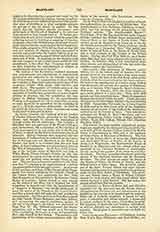

Mary, SOCIETY OF, of PARIS, founded in 1817 by Very Reverend William Joseph Chaminade at Bordeaux, France. In 1839 Gregory XVI issued a decree of commendation to the society in praise of the work done by its members. Pius IX recognized it as a religious body in 1865, and finally in 1891, after a careful examination of the special features in which the society differed notably from other orders, Leo XIII gave canonical approbation to its constitutions. In accordance with this Brief, the Society of Mary of Paris is a religious society of clerical and lay members, who make the usual simple vows of poverty, chastity, and obedience, to which at the time of their final profession they add the fourth vow of stability in the service of the Blessed Virgin. Its members are officially designated by the Roman Curia as Marianists, to distinguish them from the Marists of the Society of Mary of Lyons, founded at Lyons in 1816.
William Joseph Chaminade was born at Perigueux, France, in 1761. After his ordination, he taught in the college of Mussidan until the outbreak of the French Revolution, which drove most of the clergy from France. During this terrible period he continued the exercise of his sacred ministry in spite of the gravest dangers of arrest and death, from which, indeed, he escaped only by adopting numerous disguises and changing continually his hiding-places. At the renewal of the persecution in 1797, he was driven into exile at Saragossa, Spain, where he remained for three years. It was during this period of retreat and meditation on the needs of the Church that he matured his plans for the restoration of the Christian spirit of France. After his return to Bordeaux in 1800, his first efforts resulted in the formation of two sodalities or congregations of men and women, whose faith and zeal prompted them to cooperate with him in his efforts to repair the losses sustained by the Church in France during the Revolution. The religious influence of these sodalities was soon felt, and Father Chaminade quickly gathered around him a number of holy souls, bound to him by no other ties than those of their zeal and piety, but all eager to consecrate themselves to God under his direction for the salvation of souls. Their desires culminated in the foundation of the Daughters of Mary in 1816, and of the Society of Mary in 1817. The constitutions of the Society of Mary specify the salvation of its own members as its primary end. Its secondary end includes all works of zeal. However, Christian education specially appeals to it, and for this reason it has devoted most of its energies to the management of schools of every kind.
A distinctive feature of the Society of Mary is the composition of its membership, which, as stated above, consists of both clerical and lay members who make profession of the same four vows. Except the functions of the sacred ministry, which are necessarily restricted to the priests, and a limited number of other functions which are reserved by the constitutions, some to the priests and some to the lay members, all members may be employed, according to their ability but without distinction of class, in the various works of the order as well as in its government. In this combination of the forces of priests and laymen the founder sought to remove the limitations of usefulness to which each category would be subject without the cooperation of the other. The general superior and his assistants resided at Bordeaux until 1860, when they removed to Paris, where the headquarters of the order were maintained until the expulsion of the society from France in 1903. Since then the seat of the general administration has been at Nivelles, Belgium. The increase and expansion of the order has been rapid. In 1908 it comprised seven provinces and one vice-province, with houses in Belgium, France, Germany, Austria, Switzerland, Italy, Spain, Africa, China, Japan, the Hawaiian Islands, Canada, Mexico, and the United States. The Society of Mary was introduced into the United States in 1849, when its first house was founded in the Archdiocese of Cincinnati. In 1908 it had increased to 53 establishments, comprising 2 normal schools, 4 colleges, 3 high schools, and 44 parochial schools. Thirty-five of these communities belong to the Cincinnati province, with the residence of the provincial at Nazareth, Dayton, Ohio; the remaining eighteen form the St. Louis province, with the residence of the provincial at Chaminade College, Clayton, Missouri.
GEORGE MEYER

